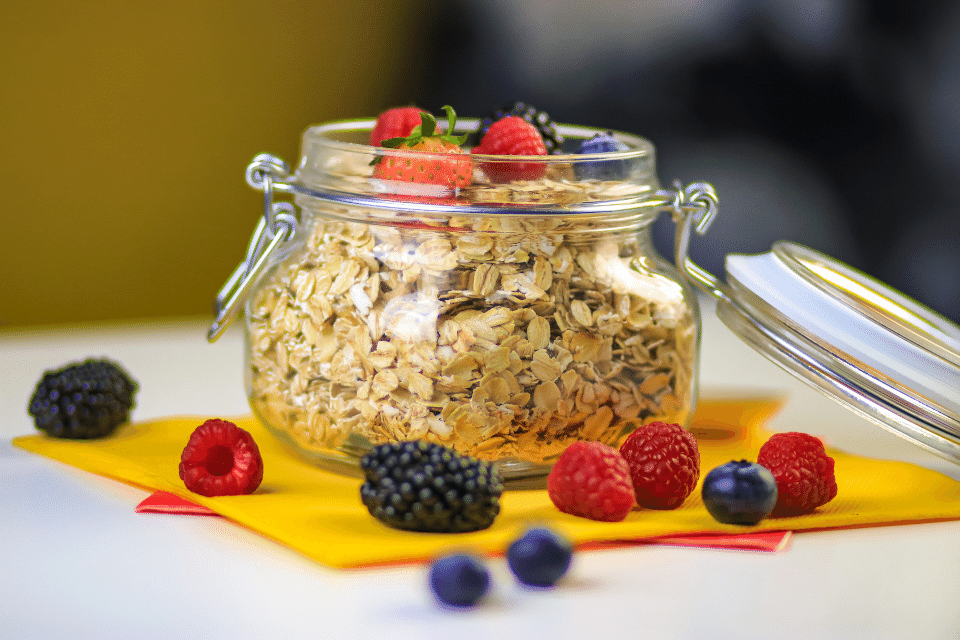Is Oatmeal Low FODMAP? From instant to overnight oats, there seems to be some variety that most people enjoy eating. They’re extremely nutrient-dense and can find a place in most diets. If you have irritable bowel syndrome (IBS), inflammatory bowel disease (IBD), or celiac disease and are focused on eating gluten-free and/or low FODMAP foods, you may be wondering if oats are gluten-free and low FODMAP? Let’s dive into a little background on oats and find out!
There are different varieties of oats.
Oats, or Avena sativa, are a type of cereal grain. Raw oats (which we don’t eat), are a type of grass in which the kernels are harvested. We consume those kernels, or seeds, in many different forms. According to the Whole Grain Council, there are six types of ways that oats are processed (1). I would add a seventh to this list, as oat milk is becoming increasingly popular!
- Whole Grain Groats: This is the most intact form of oats that you can eat. They’re cleaned, the inedible husk is removed, and what is left is the endosperm, germ, and bran.
- Steel Cut Oats: Also known as Irish oats, the whole grain groat is cut into smaller pieces with a steel blade (thus the name).
- Scottish Oatmeal: The whole grain oats are stone ground with a result that is more porridge or meal-like consistency.
- Rolled oats (traditional or old-fashioned): This is the type of oat that most people are familiar with. The groats have been steamed, rolled, and flattened to create flakes. These cook much faster than the previous oat varieties.
- Rolled oats (instant or quick): This is pretty much the same process as rolled oats, but instant/quick oats are rolled or steamed longer. The finished product absorbs water and thus cooks much more quickly.
- Oat flour: This is when the rolled oats are ground up into powder form. You can buy this pre-packaged in a store or make your own by using a food processor.
- Oat milk: The whole grain, or steel-cut, oats are mixed with water and then strained to produce oat milk. This is a good plant-based milk alternative for people with cow’s milk or nut allergies.
Are oats gluten-free?
Here is the million-dollar question: Are oats gluten-free? As with most things in nutrition, the answer is…it depends! It’s really going to depend on where you live and where the oats were grown, and how they were processed. Technically, oats are a naturally gluten-free whole grain. According to Beyond Celiac, oats may become contaminated with gluten because they are often cleaned or milled on the same machines as gluten-containing grains. Some oats are harvested, grown, and processed to ensure there is no gluten exposure (3). This is vitally important for someone who has celiac disease and needs to follow a 100% gluten-free diet.
A note on where oats are grown and processed: different countries have different laws on how oat products may be labeled. For example, Australia has much stricter laws compared to the USA and Europe. If you are someone with celiac disease, you should talk with your healthcare provider about when and how to include oats in your diet.
So, are oats low FODMAP?
In short, yes oats are low FODMAP. This may seem very confusing since I just explained that oats aren’t always gluten-free and most people associate a low FODMAP diet with a gluten-free diet. The low FODMAP diet is NOT a gluten-free diet, it just happens to include many gluten-free products. Gluten is a protein found in wheat, barley, and rye. The low FODMAP diet specifically focuses on carbohydrates. Many wheat-based products are high in the carbohydrate group fructans, which includes oats. The low FODMAP diet is very portion size-dependent, which is why oats are allowed on the diet in certain forms and portion sizes. If you are following an exclusively gluten-free diet (ex: celiac disease or non-celiac gluten sensitivity), you need to verify that the oats you are using are gluten-free. If you are just following a low FODMAP diet, you’re not technically following a gluten-free diet (hooray for sourdough bread!) and need to be aware that some gluten-free products may contain high FODMAP ingredients, like soy or oat flour.
What should I look out for on a food label?
If you’re eating oats, which are great nutrient-dense food, there are a few things to look out for. If you are following a strict gluten-free diet, the oats should be labeled as “gluten-free” or “certified gluten-free”. Be on the lookout for high FODMAP additives like honey, agave, apple, or pear juice. Those ingredients are typically found in rolled or instant oats.
Ways to include oats/oatmeal in your low FODMAP Diet:
- Country Cinnamon Oatmeal with Maple Glazed Pecans
- Peanut Butter Overnight Oats
- Blueberry Walnut Baked Oatmeal
- Chocolate Peanut Butter Energy Balls
- Oatmeal Cookie Smoothie
- Everyday Meatloaf (Check out the oat substitution!)
Hopefully, the difference between gluten-free and low FODMAP is a little bit clearer for you, and you’re walking away with a few new recipe ideas! Remember, people with a wheat allergy or celiac disease should be following a strict gluten-free diet. People with irritable bowel syndrome (IBS) may benefit from trying a low FODMAP diet. Work with a healthcare provider on implementing any of these dietary changes.
References
- “Types of Oats.” wholegrainscouncil.org. Old Ways Whole Grains Council, accessed February 3, 2022. https://wholegrainscouncil.org/whole-grains-101/easy-ways-enjoy-whole-grains/grain-month-calendar/oats-%E2%80%93-january-grain-month/types.
- “The Nutrition Source: Oats.” hsph.harvard.edu. Harvard University, accessed February 3, 2022. https://www.hsph.harvard.edu/nutritionsource/food-features/oats/.
- “Are Oats Gluten-Free?” beyondceliac.org. Beyond Celiac, accessed February 3, 2022. https://www.beyondceliac.org/gluten-free-diet/is-it-gluten-free/oats/.
- “Experts Provide Clarity on Oats in the Gluten-Free Diet.” beyondceliac.org. Beyond Celiac, April 25, 2016. https://www.beyondceliac.org/celiac-news/experts-provide-clarity-on-oats-in-the-gluten-free-diet/.
- Dwyer, Erin. “Are Oats Gluten-Free?” monashfodmap.com. Monash University, March 2, 2020. https://www.monashfodmap.com/blog/are-oats-gluten-free/.


